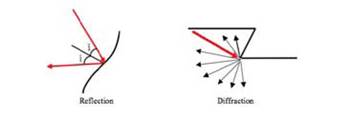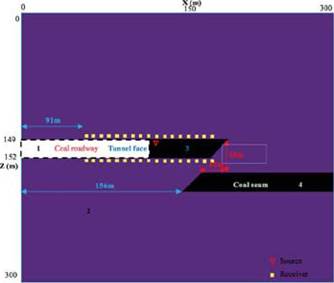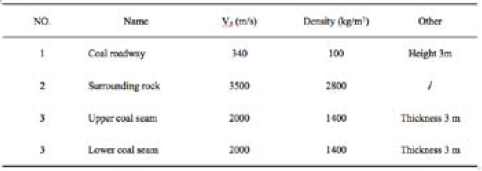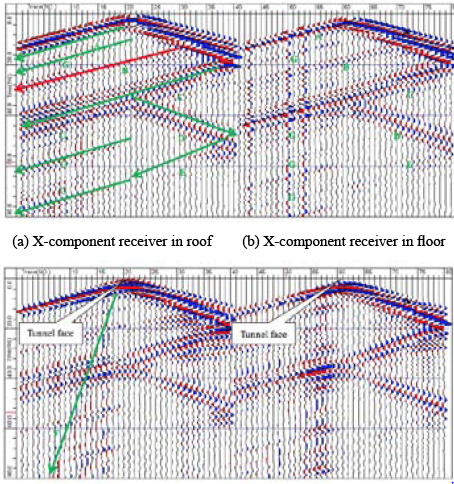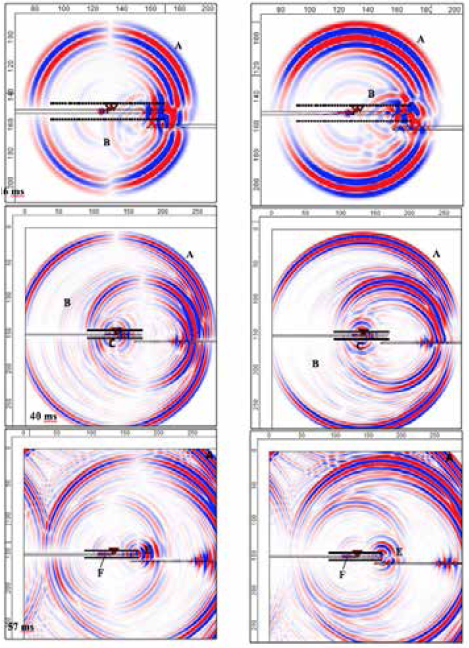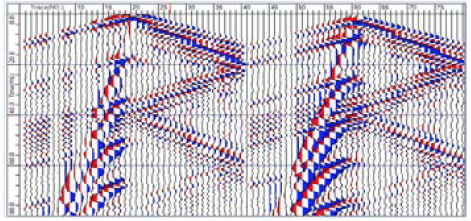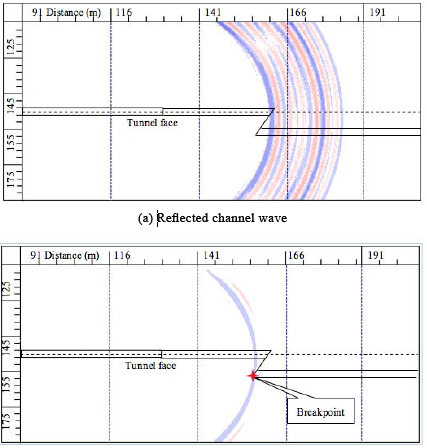1 Introduction
In China, the deaths from 2012 to 2016 was 451 because of coal mine gas accidents (Liu et al., 2016), so coal mine gas prevention and control are very grim, and gas control is the most important work of coal mine safety production. Most accidents of coal and gas outburst in tunnel face of coal roadway occur near the geological structure (Shepherd et al., 1981; Lama et al., 1998), especially small fault (Gao et al., 2015). This paper focuses on the research of small fault ahead of the tunnel face, which is the important hidden factor of coal and gas outburst accident. It is of great practical significance to the prevention and control of gas accidents.
At present, there are a lot of advanced geophysical exploration methods adopted in the roadway, which can be divided into three classes: seismic class, electromagnetic class, and other class (Roslee et al., 2017). At present, the seismic wave method is less affected by the detection environment, which is most suitable for the prediction of geological structure (Lüth et al., 2006; Jetschny et al., 2011). The seismic wave method of advanced detection mainly includes the reflected wave method, surface wave method, scattered wave method, channel wave method, diffraction method and so on (Wang et al., 2016).
The advanced detection by using reflected wave method is started early in the field of traffic tunnel. According to the launching order, seismic advanced detection technology includes: HSP, TVSP, TSP, TRT, ISIS, TGP, TSD, USP, TSWD, etc. (Inazaki et al., 1999; Otto et al., 2002; Lüth, et al., 2005; Jetschny et al., 2010). Compared with the advanced tunnel prediction, the research on reflected wave in coal roadway is few, including RTSP, MSP, etc. (Wang et al., 2015).
In the aspect of advanced detection of surface wave and scattered wave in underground coal mine, the advanced detection technique of Rayleigh surface wave was carried out in Fangezhuang Mine (Cheng et al., 2014). Zhao et al. (2006) obtained higher image positioning accuracy based on inverse scattered imaging theory. Cheng et al. (2013) studied the seismic scattered wave imaging in coal roadway by using numerical simulation method.
In the aspect of reflected channel wave, Essen et al. (2007) analyzed the response characteristics of Rayleigh channel wave of split coal through numerical simulation; Yang et al. (2012) carried out numerical simulation research with seismic wave field of small structure, and then pointed out that the Rayleigh surface wave generated from the reflection of Rayleigh channel wave can be used as the characteristic wave of the advanced detection of small structure. Lu et al. (2013) obtained the reflected channel wave by using tunnel boring machine as the source to carry out the advanced detection survey with a vertical fault with fault throw of 8m.
In the aspect of the diffraction, Yang et al. (2010) analyzed the wavefield of the advanced detection model of the geological interface, and then pointed out that the diffraction was the powerful wave to identify the interface. Deng (2012) pointed out that the diffraction of breakpoint due to the large-scale fault was the effective wave to detect the position of the coal seam. However, the studies on advanced detection in the underground coal roadway do not include the study of diffraction characteristics of small fault; therefore, the characteristics of diffraction wavefield of small fault are studied in this paper through the numerical simulation, so as to solve the fine imaging of small fault ahead of tunnel face.
2. Principle
When a seismic wave meets coal seam breakpoints, these discontinuity points can be regarded as the new sources, which can produce a kind of new disturbance to propagate around the elastic medium (Lindang et al., 2017; Kamsani et al., 2017).
This wave of disturbance is called diffraction. In essence, the physical premise of diffraction generation is the wave impedance difference and minor geological structure. The diffraction follows a concept of full wavelength, and its propagation is in agreement with the "Huygens Fresnel" principle.
The relation between the incident wave and the diffracted wave is one-to-many, while the relation between the incident wave and the reflected wave is that one-to-one, as shown in Figure 1. The reflected wave is generated when the seismic wave encounters the medium of sudden change in the propagation process, which is the change of travel time and amplitude caused by large-scale heterogeneity Lai et al., (2017). Because the fault throw in coal roadway is less than 10m, it is hard to form the reflection of the fault. However, due to the small scale of the fault and the appear wave impedance difference between coal seam and surrounding rock (the average density and P-wave velocity of coal seam and surrounding rock are respectively as: p1=1400Kg/m3, V1=2000m/s; p2=2800Kg/m3, V2=3500m/s), the obvious diffraction could be formed in the process of seismic advanced detection in coal roadway, as shown in Figure 2.
3. High-order Staggered-grid Finite Difference
In general, the structure of Coal seam is layered. Coal seam, layered roof, and floor can be regarded as horizontal isotropic media (Lai et al., 2017). The equation of the acoustic wave propagating in two-dimensional isotropic media is as follows:
Where P = P(x,z,t) represents acoustic wave field, v = v(x,z,t) represents velocity field.
The difference scheme of time second-order and space 2Nth-order difference accuracy is as follows:
The source is the spike pulse, and Ricker wavelet is used as spike pulse source and time domain formula of Ricker wavelet is as follows:
Where A is the amplitude, f0 is the dominant frequency of wavelet, t0 is the beginning time?
When the forward modeling of 2Nth-order difference accuracy in the condition of the regular grid is carried out, the stability condition is as follows:
Taking into account the requirements of computational efficiency and simulation accuracy, time two-order and space tenth-order are adopted in this paper and c(l) is 0.541. The PML absorbing boundary is adopted as a model boundary to reduce the boundary disturbance caused by the artificial boundary.
4. Wavefield Characteristics Analysis
Figure 3 shows the advanced detection model of small fault ahead of tunnel face with the fault throw of 10m. The dip angle of fault is 45 degrees, and the model size is 300 m x 300 m. The grid spacing is set as 0.25 m x 0.25 m, and sampling interval is Δt=0.1 ms. Taking into account the source features of field survey, the seismic frequency is set as 400 Hz. The coordinate range of the tunnel face is X=130 m and Z=149 ~ 152 m, while receivers are respectively located in the roadway roof and floor. The number of receivers is 40 in the roof and floor.
The receivers are located in the scope of X=91 ~ 169 m with trace intervals of 2 m. The depth of the receivers is 2 m in roof and floor. The two components X and Z are used for geophone receiving, and X direction denotes the tunneling direction, and Z direction denotes the direction being perpendicular to the floor (Roslee et al., 2017). The coordinate of the source is (134, 149), and specific medium parameters of the model are shown in Table1.
Table 1. Model parameter.
Figure 4 shows the seismic data of component X and component Z with 0~80 ms, while Figure 5 shows the wavefield snapshots of components X and Z with 16 ms, 40 ms, and 57 ms. According to the seismic records and the wavefield snapshots of the model, with reference to kinematics and dynamics characteristics of various types of seismic wave, all kinds of waves can be recognized from the complex seismic wavefield, and they are as follows: A direct P-wave, this direct P-wave is with circular propagation from the source to the surrounding rock. B Diffracted P-wave, is formed by the diffraction of the direct P-wave when propagating to breakpoint of the fault. C 1# Reflected channel wave, is formed by the reflection of the direct channel wave when encountering fault. D 2# Reflected channel wave, is formed by reflection of 1# reflection channel wave when encountering the tunnel face; E 3# reflected channel wave, is formed by the reflection of 2# reflection channel wave when encountering fault; F the roadway acoustic wave, is formed by the direct P-wave when propagating into the cavity of the roadway; G the diffracted P-waves at the endpoint of the tunnel face are the multiple diffractions when direct P-wave encounters the endpoint (Kamsani et al., 2017).
The fundamental difference B between G diffracted P-wave and diffracted P-wave is as follows: B diffracted P-wave can also be observed from the receivers ahead of tunnel face and behind tunnel face, while G diffraction can only be observed from the receivers behind tunnel face. The diffraction B can be clearly identified based on the above difference.
It can be seen from Figure 4 that the resolution of breakpoint diffraction B is highest in seismic data of component X, and the diffraction is recorded by the receivers in the floor. The waveform of the diffraction B is clear with strong energy and short-wave group. In the figure, the reflected channel wave of the fault is also obvious, but the wave group of the channel wave is wider than diffraction, which causes the low resolution when using the channel wave.
Due to the existence of the channel wave in the coal roadway and the roadway axial being parallel with the horizontal coal seam, the common observation system of the tunnel reflected wave should be with poor applicability when detecting an advanced fault. Concerning to reflection observation system commonly used in traffic tunnel (Liu et al., 2016), the sources are arranged in the rear of tunnel face, which results in Figure 6 (Kamsani et al., 2017) . From the figure, it is found that the acoustic wave in seismic data is specially developed and the diffraction of the breakpoint is not identified.
5. Advanced Imaging of Small Fault
Based on the above analysis, the diffracted P-wave and the reflected channel wave are both the effective waves of advanced detection of a small fault in coal roadway. Based on the principle of prestack diffraction migration, the contrastive study is carried out with diffraction of the breakpoint and the channel wave (Roslee et al., 2017; Lindang et al., 2017; Kamsani et al., 2017; Lai et al., 2017) . Figure 7 shows the imaging results of B diffracted P-wave and C 1# reflected channel wave of component X which is received on the floor. The starting position of X-axis is 91m.
It can be seen from Figure 7, the lateral variation range of the fault location of reflected channel wave is about 20 m, and the distribution range of the channel wave migration imaging is large, and it is difficult to determine the position of small fault. The lateral variation range of breakpoint of diffraction is about 2 m, and the wave group of diffraction is short and high resolution, and imaging position of breakpoint of small fault is in accordance with the actual model, and the direction of breakpoint in full space is easily computed by polarization migration (Wang et al., 2016).
6. Conclusion
In this paper, considering the influence of the roadway cavity and coal seam with low velocity, the advanced detection model of small fault in front of heading face is established. The numerical simulation calculation is carried out by diffraction advanced observation system. The Through comparative analysis between the diffraction and reflection observation system, and there are not acoustic wave and obvious diffracted P-wave with short wave group by diffraction observation system in seismic data of component X. Compared with multiple diffractions of the endpoint, the diffracted P-wave is clear and easy to recognize and extract, and the reason is that: Diffraction of small fault can also be observed from the receivers ahead of tunnel face, but diffraction of the breakpoint should not be observed from the receivers ahead of tunnel face. The reflected channel wave of small fault is difficult to identify because there are multiple reflected channel waves between the fault and the tunnel face. Therefore, the diffraction of coal seam breakpoint is the naturalwave of small fault, and the results of the migration show that the imaging resolution of diffraction is high and breakpoint location of imaging is consistent with the actual model.













